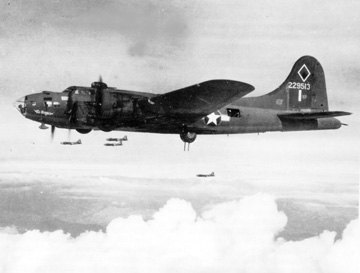Contributed Short StoriesPage 4
|
||||||||
|
OF A B-17 by George Ureke, Lt. Colonel USAF (Ret.) Flying a bombing mission out of Foggia, Italy, off Tortorella US Army Air Field in Italy, during W.W. II, our B-17 caught one hell of a lot of flack. All four engines were still running, but ALL flight instruments failed. We had no airspeed indicator. Since we were returning from the bombing mission in formation, we didn't really need flight instruments except for the approach and landing . When we arrived over the base at Tortorella, we peeled off, flying the landing pattern in trail formation. How to plan my approach with no air speed indicator? An idea came to me. We would drop behind the ship in front of us, so that on the final approach, we could establish a rate of closure to ensure that our approach would be above stall speed. |
||||||||
| Well, in the morning, when we took off, the steel mat runway was covered with three inches of slimy mud. It had been raining for weeks. Airplanes, taking off and landing just pushed the steel mat deeper into the mud. Every time an airplane took off or landed, more and more slimy mud had pushed up on top of the steel mat. So, as we approached the mud-covered runway, there were three or four inches of slippery slime on top of the mat. But, we were not worried (about coming in "hot"), until I called for flaps. | ||||||||
 |
||||||||
|
|
||||||||
| Kenneth D. Goodwin, our copilot, replied, "we don't have any". "They're not coming down" — And it was too late to crank them down by hand. We weren't about to go around again without an airspeed indicator. Due to the "hot" approach speed we didn't touch down until we were half-way down the field. |
||||||||
| The airplane in front of us made a normal landing and turned off at a taxi-strip about five-hundred feet short of the end of the runway. That pilot managed to land short enough to turn to the left onto that first taxi strip. As he turned, he looked out his left window and saw that we were halfway down the field before we touched down. | ||||||||
 |
||||||||
|
USAAF Photo |
||||||||
| He turned to his co-pilot and says, "Look out that right window. George is going to crash into the gully at the end of the runway." (Several British bombers had hit that gully in the past, and they blew up). We finally got the plane on the mud and I hit the brakes. No brakes! (in a B-I7, the pilot and copilot can look out their window and see the wheel on their side). Every time I touched the brakes, the wheels would stop, lock, and we'd hydroplane over the mud. I had one choice, something we'd normally try to avoid — "Ground-loop." I pulled No. 3 and 4 engines all the way back. I pushed No. I and 2 throttles forward to take-off power, I called for "boosters" and started tapping the right brake (trying to ground-loop to the right, and let centrifugal force tip the left wing into the ground). We'd damage the airplane but avoid crashing into the gully. Normally, the plane would turn and leave the runway. But it was so slimy, the wheels had no friction to make it turn. The plane just kept sliding forward. No. 1 and 2 engines, still at take-off power, caused the airplane to spin around while sliding straight down the runway. As it approached 180 degrees, I pushed number 3 and 4 throttles full forward. Now we had "take off' power on all four engines. There we were, going backwards, toward the end of the runway with all four engines at full take-off power. Well, we stopped right on the very end of the runway and immediately started to taxi back to the taxiway we had just passed while we were sliding backwards. You can imagine how scared our navigator, James W Collier, and the bombardier, Lowell E. Clifton, were, sitting in the nose of the airplane, as it approached the end of the runway and began to spin. This maneuver is one that I'm sure had never been done previously nor will it ever be done again. It isn't something anyone would want to practice. I can only say that on that landing, Ken Goodwin and I were both copilots. God was flying the airplane on that landing, which is why I call it the most unforgettable landing in a B-17. And, you know, we never heard from anybody. Nobody ever came to ask what had caused us to land backward. All the medals we got were for far lesser accomplishments. That's why I say, it was God who made that most unbelievable landing in a B-17. Note: If anyone who reads this was one of those men in the control tower, or otherwise saw this landing, please contact me: George Ureke, 20510 Falcons Landing, Apt. 1101, Sterling, VA 20165-7596; Phone and Fax: 703-444-6788; email. gureke~aol.com. Members of the crew: George Ureke, Pilot — Kenneth D. Goodwin, Co-pilot — James W. Cower, Navigator — Lowell E. Clifton, Bombardier — Ralph Baca , Engineer — Walter Hapenny, Radio Operator — Albert L. Murry, Waist Gunner — Warren C. Intemann, Waist Gunner — Vincent L. Manes, Tail Gunner — James S. Peters, M/Sgt USAF (Retired), Flight Engineer/Top turret 27 Missions, B17G Crew 7389 , 99 BG, 348 BS (Diamondbacks) 15 AAF 5th Wing Tortorella AAF, (Foggia #2) Foggia,Italy Dec 44-May 45 End of Page 4 Go to Short Story Listing or 06 — 07 — 08 — 09 — 10 — 11 — 12 — 13 of Short Stories Home - Contact Us - Cold War Hist. - 91st SRS Hist. - Stardust 40 Mission Story |
||||||||